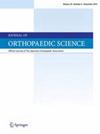关节镜踝关节置换术中加压钉对矫正屈曲畸形的影响
IF 1.5
4区 医学
Q3 ORTHOPEDICS
引用次数: 0
摘要
背景:关节镜下踝关节置换术(AAA)与开放式关节置换术相比,具有骨结合率高、创伤小、住院时间短等优点,因此很受欢迎。然而,术后经常会观察到严重的屈曲畸形,这可能会导致骨不愈合、疼痛和邻近关节关节化。加压钉可在骨表面提供持续、强大的压迫力。本研究旨在通过比较加压钉和螺钉固定与单纯螺钉固定在术前和术后的效果,明确AAA在对位矫正方面的差异:对67名接受AAA手术的患者的70只脚踝进行了回顾性研究。53只脚踝接受了胫骨远端三枚螺钉固定的AAA手术,17只脚踝接受了加压钉和两枚螺钉固定的AAA手术。在关节镜下准备好关节表面后,S组患者在胫骨内侧植入了三枚松质骨螺钉。CS组患者则在胫腓骨关节外侧植入一枚压迫钉,并在内侧植入两枚螺钉。对两种手术的临床评分和术前术后平片对位情况进行比较:结果:日本足部外科学会的术前和术后评分没有明显差异。S组有一个踝关节出现不愈合。两组的距骨倾斜度和胫腓角无明显差异。CS 组的胫骨平台角明显低于 S 组(p 结论:CS 组的胫骨平台角明显低于 S 组):与仅使用螺钉固定的 AAA 相比,使用加压钉和双螺钉固定的 AAA 可以获得更理想的对位,即使在严重屈曲畸形的病例中也是如此。本文章由计算机程序翻译,如有差异,请以英文原文为准。
Effect of a compression staple on correction of varus deformity during arthroscopic ankle arthrodesis
Background
Arthroscopic ankle arthrodesis (AAA) has become popular because of its higher rate of bone union, lower invasiveness, and shorter hospital stays compared to those of open arthrodesis. However, postoperative malalignment is often observed for severe varus deformity, which can cause nonunion, pain, and adjacent joint arthrosis. A compression staple can provide a persistent, strong compressive force on the bone surface. This study aimed to clarify the difference in alignment correction in AAA by comparing a compression staple and screws fixation with screws-only fixation pre- and postoperatively.
Methods
Seventy ankles in 67 patients undergoing AAA were retrospectively reviewed. AAA with three screws through the distal tibia was performed in 53 ankles, and 17 ankles underwent AAA with a compression staple and two screws. After the preparation of the joint surface arthroscopically, patients in the S group had three canulated cancellous screws inserted through the medial tibia. Patients in the CS group had a compression staple placed at the lateral aspect of the tibiotalar joint and two screws inserted through the medial side. Clinical scores and pre-and postoperative alignment on plain radiographs were compared between the two procedures.
Results
There were no significant differences in the pre-and postoperative Japanese Society for Surgery of the Foot scale. One ankle in the S group exhibited nonunion. There were no significant differences in talar tilt and tibiotalar angles between the groups. The tibial plafond angle in the CS group was significantly lower than that in the S group (p < 0.05). Postoperatively, talar tilt and tibiotalar angles on the coronal image, and the lateral tibiotalar angle in the CS group were significantly lower than those in the S group (p < 0.05).
Conclusion
AAA with a compression staple and two-screw fixations could obtain more optimal alignments than AAA with screw-only fixation, even in cases with severe varus deformity.
求助全文
通过发布文献求助,成功后即可免费获取论文全文。
去求助
来源期刊

Journal of Orthopaedic Science
医学-整形外科
CiteScore
3.00
自引率
0.00%
发文量
290
审稿时长
90 days
期刊介绍:
The Journal of Orthopaedic Science is the official peer-reviewed journal of the Japanese Orthopaedic Association. The journal publishes the latest researches and topical debates in all fields of clinical and experimental orthopaedics, including musculoskeletal medicine, sports medicine, locomotive syndrome, trauma, paediatrics, oncology and biomaterials, as well as basic researches.
 求助内容:
求助内容: 应助结果提醒方式:
应助结果提醒方式:


